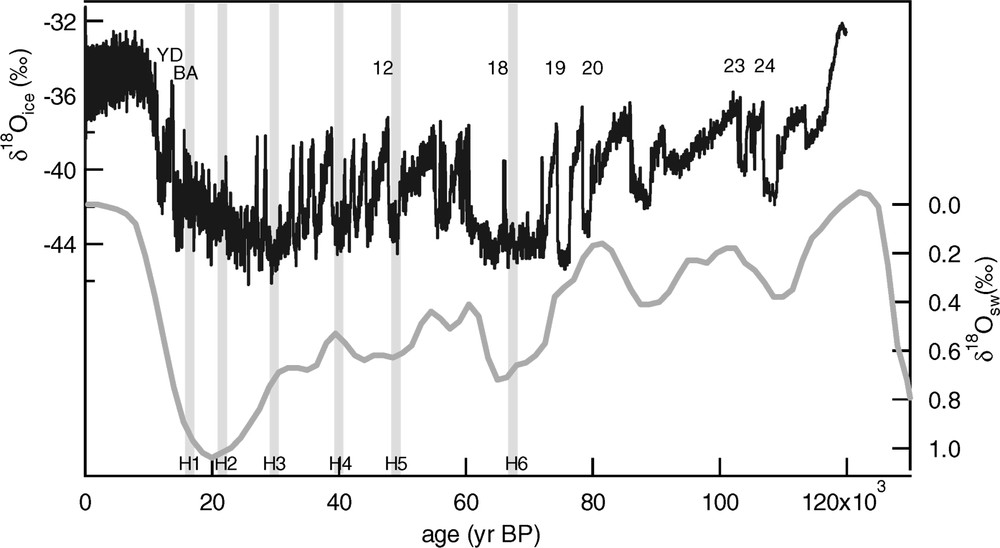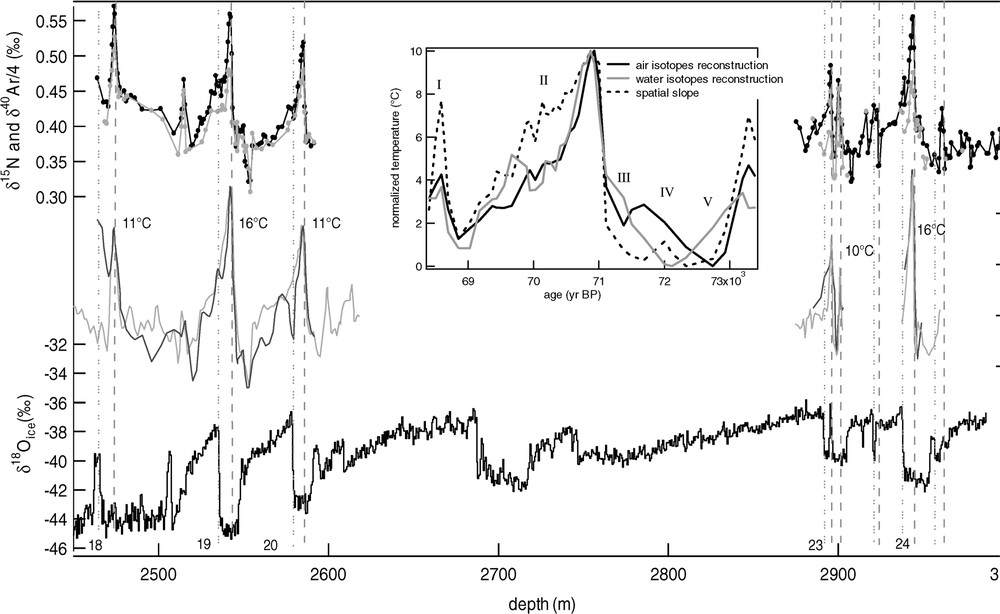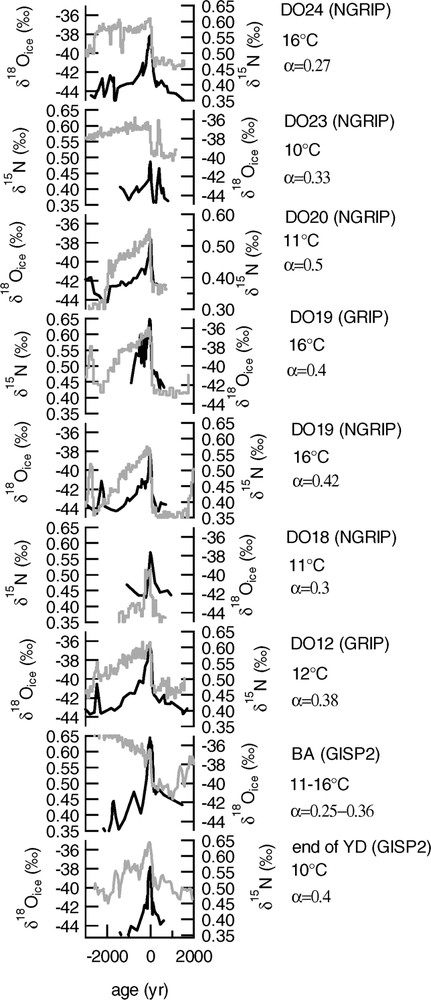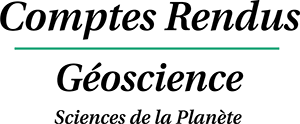Version française abrégée
L'enregistrement de la variabilité climatique rapide de la dernière période glaciaire est obtenu à haute résolution par le profil des isotopes de l'eau dans les carottes de glace du Groenland [9,21,37] (Fig. 1). Traditionnellement, la température y est reconstruite à partir de la relation spatiale observée actuellement entre isotopes de l'eau et température. Cependant, à cause de biais liés à la saisonnalité des précipitations et aux changements de température des régions d'évaporation des masses d'eau, de telles reconstructions des variations de température sont sous-estimées, jusqu'à un facteur 2, pour la dernière période glaciaire [4,6,7,11,22,24,26,46].

Top: full record of the
En haut : enregistrement complet du
En haut : enregistrement complet du
Une méthode alternative basée sur la mesure conjointe des isotopes de l'azote (
À partir de cette méthode, nous avons mesuré un profil continu à haute résolution de
Sur le DO 19, nous montrons en effet une reconstruction à haute résolution de la température à partir des isotopes de l'air sur l'intégralité de l'événement (c'est-à-dire pas seulement restreinte à l'amplitude du réchauffement rapide). Elle confirme une forme très différente de la température de surface déduite des isotopes de l'air par rapport au profil

DO 18, 19, 20, 23 and 24 in the NorthGRIP ice core. Top:
DO 18, 19, 20, 23 and 24 in the NorthGRIP ice core. Top:
DO 18, 19, 20, 23 et 24 dans la carotte de NorthGRIP sur une échelle de profondeur. En haut :
DO 18, 19, 20, 23 et 24 dans la carotte de NorthGRIP sur une échelle de profondeur. En haut :
Finalement, nous présentons une compilation des différents résultats existants sur les DO au Groenland à partir des isotopes de l'air et de l'eau (Fig. 3). Une telle comparaison montre la difficulté de décrire de façon générique un DO. Les DO 12 et 19 semblent ainsi les plus proches sur la base de leur enregistrement au Groenland – (i) refroidissement progressif pendant la phase chaude et (ii) petit réchauffement abrupt 2000 ans après le réchauffement principal –, mais les enregistrements marins montrent que, si le réchauffement abrupt du DO 12 est précédé par une décharge d'icebergs depuis la calotte laurentienne (événement de Heinrich), aucune décharge massive n'a été enregistrée avant le réchauffement abrupt du DO 19 [10]. Il semble donc difficile de relier directement le scénario de température de surface des DO avec les décharges d'icebergs dans l'Atlantique nord.

Comparison of different DO in GRIP, GISP2 and NorthGRIP:
Comparison of different DO in GRIP, GISP2 and NorthGRIP:
Comparaison de différents DO à GRIP, GISP2 et NorthGRIP :
Comparaison de différents DO à GRIP, GISP2 et NorthGRIP :
1 Introduction
The first evidence for the succession of rapid climatic events in the northern hemisphere during the last glacial period has been provided by the Greenland ice cores [9,21]. Records for that rapid climatic variability were then obtained in numerous marine [2,10,27] and continental archives [5,15,45] in the northern hemisphere and associate events are depicted in the Antarctic ice cores [1]. Despite this sum of information at lower latitudes, Greenland ice cores still provide the more detailed and continuous climatic record of the last glacial period. Among other things, (i) water isotopes profiles (Fig. 1) depict surface-temperature changes [21], (ii) ice chemical contents reflect changes in atmospheric circulation and source conditions [13], and (iii) greenhouse gases concentration (CH4, N2O) fluctuations parallel temperature changes [12]. The water isotopes enable one to clearly describe the succession, over a DO, of a rapid
The conventional reconstruction of the temperature profile is based on the spatial linear relationship observed today between surface temperature and ice isotopic composition
Another palaeothermometry method was developed from the direct temperature measurements in the borehole and it is based on the heat equation inversion. The most important result of this method for the glacial period is the estimate of the last glacial maximum temperature to
More recently, an alternative method has been proposed to infer the amplitude of the rapid temperature changes [39,40]. It takes advantage of the thermal diffusion that fractionates the atmospheric gases in the firn (constituted of porous snow in the upper 50–120 m of the polar ice-sheet before the pore close-off). The precise temperature estimate requires a high analytical precision, an accurate calibration of the thermal effect and the use of a heat-diffusion model to link the thermal gradient in the firn to the surface temperature change [23]. This method has already been applied to different rapid climatic events leading to the same conclusion than the one drawn from the borehole temperature measurements: the conventional use of the water isotopes underestimates by a factor 1.5–2 the amplitude of the rapid temperature changes during the last glacial [32,33,39,40].
We concentrate here on this new method to study the temperature evolution over DO in Greenland. We first describe the method and its potential to determine precisely the amplitude of the rapid temperature changes. We then apply it to the surface temperature reconstruction over sequences of DO at the onset of the glacial cycle at NorthGRIP. Finally, we present a comparison of rapid events on which air isotopic measurements were performed to compare the temporal evolution of surface temperature during a variety of DO at the beginning, middle or end part of the last glacial period.
2 An overview of the method
The repartition of air isotopes before enclosure at the bottom of the firn is imposed by thermal and gravitational fractionations if the gas species have a constant atmospheric isotopic composition. The nitrogen isotopic composition can possibly show temporal variations through biological processes (denitrification). However, since the residence time of N2 in the atmosphere is more than 107 years, even the large consumption of nitrogenous fertilizer during recent time does not modify the atmospheric
The gravitational fractionation is simply imposed by the gravity field on the Earth, g. It drives the heavier isotopes towards the bottom end resulting in the barometric equation:
The
Here, we use the first method owing to a high analytical precision both on
3 Results
Our
Fig. 2 depicts the
We clearly confirm that the spatial relationship applied to the abrupt changes of surface
The use of air isotopic measurements can moreover be extended to the reconstruction of the complete temperature history over a sequence of DO if a detailed record of
Some small but significant
Finally, the palaeothermometry method based on air isotopic measurements requires a precise analytical setup and the development of a precise firn modelling tool. However, this method provides unique results on the temperature scenario for rapid events that neither the water isotopic measurements nor the borehole temperature measurements can resolve. Using this method enables us to propose a new shape for the high-latitude-temperature scenario over a DO that should be considered for further modelling studies.
4 Comparison of DO events:
Using the
We show a wide variety of DO characterized by rapid warming events ranging from 10 to 16 °C both in Summit (GRIP and GISP2) and in NorthGRIP. The temporal slope between water isotopes and the reconstructed surface-temperature variations confirms that the
The last point can be deepened by comparing on the one hand DO 12 (GRIP) and 19 (NorthGRIP) and, on the other hand, DO 18. DO 12 and 19 depict similar
To end up with the variety of rapid events, the specificity of DO 23 and 24 should be highlighted. Their
5 Conclusion
We presented here a recently developed palaeothermometry method that applies to the rapid climatic variability recorded in the Greenland ice cores. Whereas (i) the conventional method based on the
Acknowledgements
This work was supported by the French CNRS (PNEDC), the CEA and the Balzan Foundation. We thank the NorthGRIP and GRIP participants for their collaborative efforts. Bénédicte Minster helped with air isotopic measurements. A.L. is funded by a Lady Davis Fellowship and the Israeli Science Foundation.



Vous devez vous connecter pour continuer.
S'authentifier